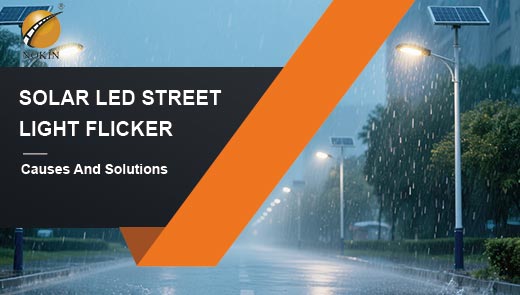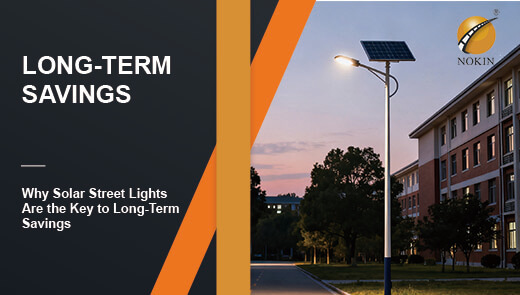What Are the Best Solar Panels for LED Street Lights?
As the global commitment to sustainable development continues to grow, solar-powered LED street lights have emerged as a green alternative to traditional grid-powered street lights. Thanks to their environmental friendliness, energy efficiency, and cost-effectiveness, they are gaining widespread adoption in both urban and rural lighting applications. In a solar street light system, the solar panel is the core component, and its performance directly determines the system's power generation efficiency, runtime, and overall lifespan.
However, the current market offers a wide variety of solar panel types with differing technical specifications, leaving many users confused about which solar panel is most suitable for LED street lights. This article will provide a detailed overview of the mainstream solar panel types suitable for LED street lights, the cost differences between different types, key considerations for selection, and the significant advantages of using solar panels, offering you a comprehensive and practical reference guide.
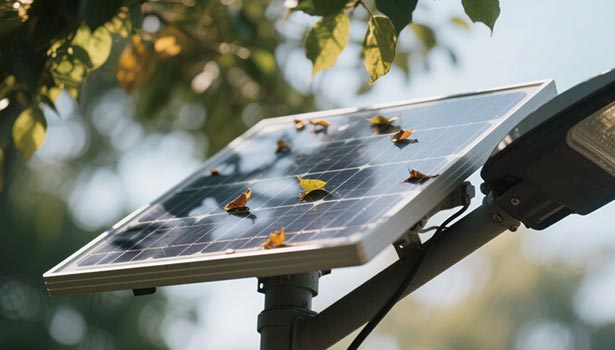
Types of Solar Panels Used in Solar Street Lights
Crystalline Solar Panels
Crystalline silicon solar panels are the mainstream choice in the solar street light industry, primarily divided into monocrystalline and polycrystalline types. Monocrystalline silicon solar panels are made from a single silicon crystal. The manufacturing process involves growing cylindrical silicon ingots using the Czochralski method, followed by slicing the ingots into thin wafers and processing them into solar cells. They have a black appearance and relatively high conversion efficiency, typically ranging from 15% to 22%.
Although monocrystalline silicon panels were once more expensive to manufacture than polycrystalline silicon panels, their prices have significantly decreased with technological advancements. Monocrystalline silicon panels are highly versatile and suitable for various types of solar street lights, including split-type, two-in-one, and integrated designs, currently dominating the solar street light market.
Polycrystalline silicon solar panels are composed of multiple silicon crystals. The manufacturing process involves pouring molten silicon into molds to form square or rectangular silicon wafers. They have a blue appearance and a lower conversion efficiency than monocrystalline silicon panels. Due to the relatively simple manufacturing process, polycrystalline silicon panels are produced using silicon fragments rather than pure silicon crystals, resulting in lower costs compared to monocrystalline silicon panels. However, due to their efficiency disadvantages, polycrystalline silicon panels are increasingly less common in solar street lights.
PERC Solar Panels
PERC (emitter and rear passivated cell) solar panels are an improved version of crystalline silicon panels, capable of generating 10%-30% more electricity than traditional crystalline silicon panels. PERC solar panels feature passivation layers on both the front and back sides of the cells. This design reduces surface recombination of electrons and holes, thereby significantly improving conversion efficiency. Additionally, the back-contact design allows more light to be absorbed and converted into electricity.
In recent years, the application of PERC solar panels has seen rapid growth. When used in solar street lights, they not only improve energy conversion efficiency and support higher-power lighting modules but also allow for the use of smaller, more compact panels while maintaining the same power output, thereby enhancing the overall aesthetic appeal of the street lights.
Bifacial Solar Panels
Bifacial solar panels are based on crystalline silicon technology, with their light-absorbing layers cleverly sandwiched between two layers of tempered glass or transparent plastic. This unique design increases power generation and significantly improves performance under specific conditions. Research indicates that in environments with ample diffuse light or reflective surfaces (such as snow-covered areas or light-colored roadways), bifacial solar panels achieve an average efficiency approximately 20–30% higher than traditional panels.
Due to their ability to absorb light from both sides, bifacial panels are highly suitable for solar street lights to enhance energy output. They offer flexible installation options, including mounting on the top of a light pole, on the lamp housing, or vertically attached to the pole. However, it is important to note that bifacial panels have stringent requirements for material quality and encapsulation technology; otherwise, they are more prone to damage under harsh weather conditions.
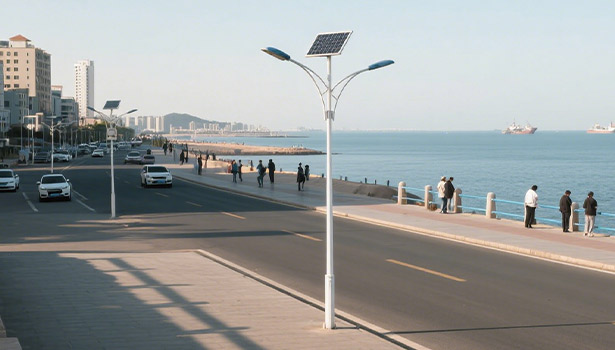
Thin-Film Solar Panels
Although thin-film solar panels were invented in the 1970s, they have only recently gained widespread attention and application in the solar street light industry.
They offer numerous advantages, including lower costs and more environmentally friendly manufacturing processes. The following characteristics further position them as an innovative force in the industry: Thin-film solar panels are lightweight, flexible, and bendable, providing more design possibilities for street light panel modules.
Vertical solar street lights often use this type of panel, which can be installed in various ways: first, it can be embedded into the four sides of a square lamp post; second, it can be processed into long strips, assembled into a polygonal tubular structure, or rolled into a cylindrical shape and wrapped around the lamp post. This design gives solar street lights a modern appearance that aligns with contemporary aesthetic preferences.
Additionally, thin-film solar panels maintain good efficiency under weak light conditions such as cloudy weather and have an excellent temperature coefficient, making them less sensitive to temperature changes and resulting in minimal efficiency loss in high-temperature environments.
Other Solar Panels
From a technical perspective, IBC (interdigitated back contact) and HJT (heterojunction technology) solar panels can also be used for street lights. However, in addition to efficiency factors, cost is a key deciding factor. These new types of panels require modification from standard models to a style suitable for street lights. Due to insufficient mass production, the modification costs are relatively high, and long-term maintenance costs also remain uncertain. For example, IBC and HJT panels are more expensive than PERC panels, so their application in the street light industry is currently extremely rare.
How Expensive are Different Types of Solar Panels?
Monocrystalline Solar Panels
Monocrystalline silicon solar panels are typically the most expensive type. Their manufacturing process uses the Czochralski method, which is energy-intensive and results in silicon material waste (though this waste silicon can be reused in the production of polycrystalline silicon panels), leading to relatively high overall costs.
Polycrystalline Solar Panels
Polycrystalline silicon solar panels are less expensive than monocrystalline silicon panels. Since their production uses silicon fragments rather than pure silicon crystals, the manufacturing process is simpler, reducing both manufacturers' production costs and installation costs for installers.
Thin-film Solar Panels
The cost of thin-film solar panels varies depending on the specific type. Among them, CdTe is the type of thin-film battery with the lowest manufacturing cost; the production cost of CIGS thin-film batteries is higher than that of CdTe and amorphous silicon. In terms of overall installation costs, thin-film panels are generally lower than crystalline silicon panels because they are lightweight and easy to handle, reducing labor costs during installation.
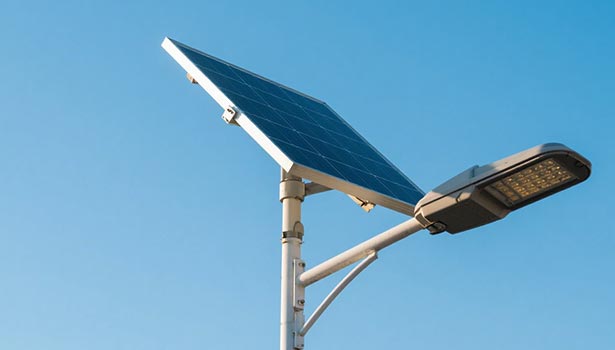
PERC Solar Panels
PERC and bifacial solar panels have higher costs than standard crystalline silicon panels. However, due to their higher conversion efficiency, they can achieve cost savings over the long term by reducing energy consumption, thereby offsetting the initial higher investment to some extent.
Factors to Consider in Panel Selection
Energy Efficiency
In street lighting applications, high energy conversion efficiency is critical as it directly impacts power generation. High-efficiency panels can generate more electricity under the same lighting conditions, thereby improving overall system performance and saving energy. For areas with limited lighting conditions, high-efficiency panels such as PERC and monocrystalline silicon panels should be prioritized.
Durability and Weather Resistance
Street lights are exposed to various weather conditions, including rain, snow, and extreme temperatures, over extended periods. Therefore, solar panels capable of withstanding these environmental factors must be selected. When choosing panels, prioritize those made with high-quality materials (such as tempered glass and durable frames) and featuring waterproof coatings to ensure long-term reliability. For bifacial panels, particular attention should be given to encapsulation quality to ensure they can withstand harsh climatic conditions.
Size and Power Output
The size and power output of solar panels should be matched to the specific requirements of the street light system. Factors such as required brightness, runtime, and geographical location (light intensity) should be considered to determine the appropriate panel size and power capacity. Oversized panels may result in unnecessary cost waste, while undersized panels may fail to meet lighting requirements, affecting the normal operation of street lights.
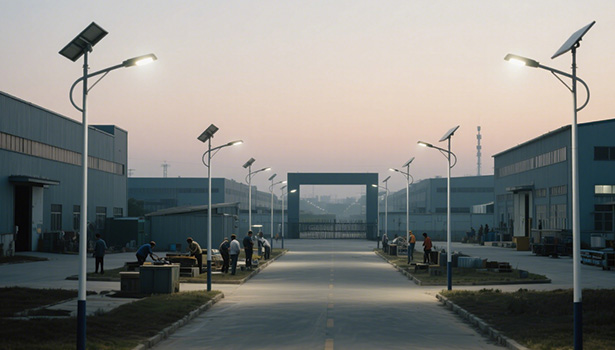
Benefits of Using Solar Panels in Street Lights
Environmental Sustainability
Solar street lights utilize clean, pollution-free solar energy, reducing carbon emissions and dependence on fossil fuels. This is of significant importance in addressing climate change and promoting the development of a green future, serving as an effective measure to practice the concept of environmental sustainability.
Cost Savings
Solar street lights offer long-term cost savings. They do not rely on traditional power grids, thereby reducing electricity bills and related maintenance costs; simultaneously, they eliminate the need for large-scale power infrastructure installation, significantly reducing various expenses during installation and operation. In the long run, this can provide users with substantial economic benefits.
Flexible Installation
Traditional street lights are constrained by grid coverage, and installing them in remote areas (such as mountainous regions, rural areas, or deep within scenic spots) requires the additional construction of long-distance power transmission lines, which is extremely costly and logistically challenging. In contrast, solar street lights generate their own electricity via solar panels and do not rely on the grid, enabling rapid installation in any area with sunlight. Whether on urban main roads, residential area walkways, highway service areas, forest fire prevention paths, or even temporary construction sites, solar street lights can be flexibly deployed, particularly suitable for regions with weak infrastructure to achieve “off-grid lighting.”
Enhancing Power Supply Stability and Safety
During extreme weather conditions such as heavy rain or typhoons, traditional power grids may experience outages due to line failures, causing street lights to go out and affecting road safety. Solar street lights operate independently, with the power supply of individual fixtures unaffected by other equipment or grid failures. Even if some fixtures malfunction, it will not result in the entire area being left without lighting. Additionally, solar street lights do not require exposed wires or high-voltage equipment, reducing safety hazards such as electric shocks or fires caused by aging lines, making them particularly suitable for densely populated areas like squares or school surroundings.
When selecting solar panels for solar LED street lights, factors such as efficiency, cost, durability, and environmental impact must be considered. Monocrystalline silicon, PERC, bifacial, and thin-film panels each have their specific applications. Regardless of the choice, this integration represents a vivid example of sustainable development. As technology advances, the role of solar street lights in the global lighting sector will become increasingly significant, contributing to the creation of environmentally friendly and intelligent living environments.


